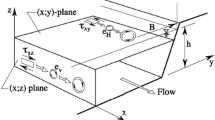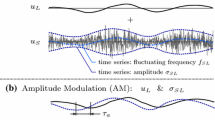Abstract
We have analyzed signals containing intermittent coherent structures using a nonorthogonal dyadic wavelet transform. The coherent structures may be zones of concentrated shear or zones determined by regions of turbulent transport of scalar fields. Coherent structures in velocity or scalars have important influences on flux transport. Additionally, coherent structures in velocity determine certain spectral characteristics of the velocity signals. Therefore, the decomposition of observed signals into structures and non-structures is important for associating mechanisms to flux transport and characterizing spectra of signals exhibiting intermittent events.
We develop techniques based on the wavelet transform to provide a signal decomposition which preserves coherent structures. The decomposition is used to separate the signal into two components, one of which contains the important structures. Embedded within the technique are a coherent structure detection mechanism, an analysis of intermittency resulting in an intermittency index, and a filtering technique. We illustrate the dependence of the coherent structure detection mechanism on the choice of analyzing wavelet, demonstrating that anti-symmetric wavelets are better suited to detecting zones of concentrated shear, while symmetric wavelets result in detection of zones of concentrated curvature.
We apply these techniques to the velocity components, virtual potential temperature, and buoyancy flux density records from a portion of the data collected during the First International Satellite Land Surface Climatology Project (ISLSCP) Field Experiment 87 (FIFE87). An analysis of buoyancy flux in a convective, unstable boundary layer shows that the buoyancy flux is due to a combination of temperature structures and momentum structures which is consistent with conceptual models of a convective boundary layer. Spectral estimates of each of the partitions for the velocity signals are compared to the non-partitioned velocity signals. The characteristics of the partition reveal that the structure-containing component of the velocity records follows a classical spectral description having a −5/3 slope in the inertial range, while the non-structure component is essentially flat or has a −1 slope. These can then be associated with strong and weak turbulence regimes, respectively. Furthermore, the −5/3 region in the structure component may be attributed to the effects of intermittency, providing some evidence that large-scale eddies transfer energy directly to small scales.
Similar content being viewed by others
References
Antonia, R. A., Chambers, A. J., Friehe, C. A. and Van Atta, C. W.: 1979, ‘Temperature Ramps in the Atmospheric Surface Layer’,J. Atmos. Sci. 36, 99–108.
Arneodo, A., Grasseau, G. and Holschneider, M.: 1989, ‘Wavelet Transform Analysis of Invariant Measures of Some Dynamical Systems’, in: J. M. Combes, A. Grossman and Ph. Tchamitchian (eds.),Wavelets, Springer-Verlag, 315 pp.
Bergström, H. and Högström, U.: 1989: ‘Turbulent Exchange above a Pine Forest II. Organized Structures’,Boundary-Layer Meteorol. 49, 231–263.
Chui, C. K.: 1992,An Introduction to Wavelets. Academic Press, Inc. 266 pp.
Collineau, Serge, and Brunet, Yves: 1993, ‘Detection of Turbulent Coherent Motions in a Forest Canopy; Part I: Wavelet Analysis’,Boundary-Layer Meteorol. 65, 357–379.
Daubechies, I.: 1988, ‘Orthonormal Bases of Compactly Supported Wavelets’,Communications in Pure and Appl. Math. 41, 909–996.
Daubechies, I.: 1992,Ten Lectures on Wavelets. CBMS-NSF Regional Conference Series in Applied Mathematics, Soc. for Industrial and Appl. Math., 357 pp.
Davis, K., Hagelberg, C. and Gamage, N.: 1993 (in preparation), ‘An Objective Method for Determining Atmospheric Structure from Airborne Lidar Observations’.
Gamage, N. K. K.: 1989,Modelling and Analysis of Geophysical Turbulence: Use of Optimal Transforms and Basis Sets. Ph.D. Thesis, Oregon State University, 135 pg. [Available from University Microfilm, 305 N. Zeeb Rd., Ann Arbor, MI 48106.]
Gamage, N. K. K. and Blumen, W.: 1993, ‘Comparative Analysis of Low-Level Cold Fronts: Wavelet, Fourier and Empirical Orthogonal Function Decompositions’,Mon. Weather Rev. 121, 2867–2878.
Gamage, N. K. K. and Hagelberg, C.: 1993, ‘Detection and Analysis of Microfronts and Associated Coherent Events using Localized Transforms’,J. Atm. Sci. 50, 750–756.
Grossman, Robert L.: 1992, ‘Convective Boundary Layer Budgets of Moisture and Sensible Heat Over an Unstressed Prairie’,J. Geophys. Res. 97(D17), 18,425–18,438.
Hagelberg, C. R. and Gamage, N. K. K.: 1993 (in press), ‘Application of Structure Preserving Wavelet Decompositions to Intermittent Turbulence: A Case Study’, in: E. Foufoula-Georgiou and P. Kumar (eds.),Wavelet Transforms in Geophysics, Vol. IX in Wavelet Analysis and its Applications, C. Chui, series editor, Academic Press, 1994.
Harris, F. J.: 1978, ‘On the Use of Windows for Harmonic Analysis with the Discrete Fourier Transform’,Proc. of the IEEE 66, 51–83.
Hudgins, L. H., Mayer, M. E. and Friehe, C. A.: 1993, ‘Fourier and Wavelet Analysis of Atmospheric Turbulence’, inProc. of the Wavelets and Applications Conference, Toulouse, France, (to appear).
JGR special issue, November, 1992: First ISLSCP Field Experiment.J. Geophys. Res. 97, November 1992. 18343–19110.
Kristensen, L., Kirkegaard, P., Fairall, C. W., Kaimal, J. C. and Lenschow, D. H.: 1992, ‘Advantages of Tapering Finite Data Records for Spectral Analysis’, NOAA Technical Memorandum ERL WPL-266, National Technical Information Service, Springfield, VA.
Kuznetsov, V. R., Praskovksy, A. A. and Sablenikov, V. A.: 1992, ‘Fine-Scale Turbulence Structure of Intermittent Shear Flows’,J. Fluid. Mech. 243, 595–622.
Lenschow, D. H. and Stephens, P. L.: 1980, ‘The Role of Thermals in the Convective Boundary Layer’,Boundary-Layer Meteorol. 19, 509–532.
Mahrt, L.: 1991, ‘Eddy Asymmetry in the Sheared Heated Boundary Layer’,J. Atm. Sci. 48, 472–492
Mahrt, L. and Gamage, N.: 1987, ‘Observations of Turbulence in Stratified Flow’,J. Atm. Sci. 44(7), 1106–1121.
Mallat, S.: 1989, ‘Multifrequency Channel Decompositions of Images and Wavelet Models’,IEEE Trans. on Acoustics, Speech, and Signal Processing,37, 2091–2110.
Mallat, S. and Zhong, S.: 1992, ‘Characterization of Signals from Multiscale Edges’,IEEE Trans. on Pattern Anal. and Mach. Intel. 14, 710–732.
Mallat, S. and Hwang, W. L.: 1992, ‘Singularity Detection and Processing with Wavelets’,IEEE Trans. on Inform. Theory,38, 617–643.
Schols, J. L. J.: 1984, ‘The Detection and Measurement of Turbulent Structures in the Atmospheric Boundary Layer’,Boundary-Layer Meteorol. 29, 39–58.
Taubenheim, J.: 1989, ‘An Easy Procedure for Detecting a Discontinuity in a Digital Time Series’,Zeitschrift Meteorol. 39, 344–347.
Tennekes, H. and Lumley, J. L.: 1972.A First Course in Turbulence, The MIT Press, Cambridge, Mass., 300 pp.
Yamada, M. and Ohkitani, K.: 1990, ‘Orthonormal Wavelet Expansion and its Application to Turbulence’,Progress in Theoretical Physics 83(5), 819–823.
Yamada, M. and Ohkitani, K.: 1991, ‘Orthonormal Wavelet Analysis of Turbulence’,Fluid Dynamics Res. 8, 101–115.
Author information
Authors and Affiliations
Rights and permissions
About this article
Cite this article
Hagelberg, C.R., Gamage, N.K.K. Structure-preserving wavelet decompositions of intermittent turbulence. Boundary-Layer Meteorol 70, 217–246 (1994). https://doi.org/10.1007/BF00709120
Revised:
Issue Date:
DOI: https://doi.org/10.1007/BF00709120




